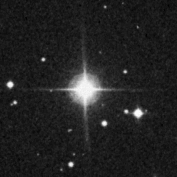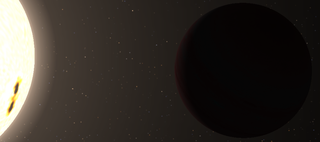HD 88133 is a yellow star with an orbiting exoplanet in the equatorial constellation of Leo. It has an apparent visual magnitude of 8.01, which is too faint to be visible to the naked eye. With a small telescope it should be easily visible. The distance to this system, as measured through parallax, is 240 light years, but it is slowly drifting closer with a radial velocity of −3.6 km/s.
The Hungarian Automated Telescope Network (HATNet) project is a network of six small fully automated "HAT" telescopes. The scientific goal of the project is to detect and characterize extrasolar planets using the transit method. This network is used also to find and follow bright variable stars. The network is maintained by the Center for Astrophysics | Harvard & Smithsonian.
The XO Project is an international team of amateur and professional astronomers tasked with identifying extrasolar planets. They are led by Peter R. McCullough of the Space Telescope Science Institute. It is primarily funded by NASA's Origins Program and the Director's Discretionary Fund of the Space Telescope Science Institute.
HD 185269 is a stellar triple system approximately 170 light-years away in the constellation Cygnus. It is easily visible to binoculars, but not the naked eye.

HD 136118 is a star in the Serpens Caput section of the Serpens constellation. The star is too dim to be readily visible to the naked eye, having an apparent visual magnitude of 6.93. It is located at a distance of 165 light years from the Sun based on parallax, and is drifting closer with a radial velocity of −3 km/s.
HD 43691 is a star with an orbiting exoplanet in the constellation Auriga. With an apparent visual magnitude of 8.03, it is too faint to be visible to the naked eye. This system is located at a distance of 279 light years based on parallax measurements, but is drifting closer with a heliocentric radial velocity of −29 km/s.

HAT-P-5b is a transiting extrasolar planet located approximately 1000 light-years away in the constellation of Lyra, orbiting the star HAT-P-5. It is a hot Jupiter with a mass 6% greater than Jupiter and a radius 26% greater than Jupiter, corresponding to a density of 0.66 g/cm3, which is less than water. This planet was found by Bakos et al. on October 9, 2007.
HD 118203 is a star with an orbiting exoplanet located in the northern circumpolar constellation of Ursa Major. It has the proper name Liesma, which means flame, and it is the name of a character from the Latvian poem Staburags un Liesma. The name was selected in the NameExoWorlds campaign by Latvia, during the 100th anniversary of the IAU.
WASP-7, also identified as HD 197286, is a type F star located about 520 light years away in the constellation Microscopium. This star is a little larger and about 28% more massive than the Sun and is also brighter and hotter. At magnitude 9 the star cannot be seen by the naked eye but is visible through a small telescope.

CoRoT-3b is a brown dwarf or massive extrasolar planet with a mass 21.66 times that of Jupiter. The object orbits an F-type star in the constellation of Aquila. The orbit is circular and takes 4.2568 days to complete. It was discovered by the French-led CoRoT mission which detected the dimming of the parent star's light as CoRoT-3b passes in front of it.

WASP-4 is a G-type main-sequence star approximately 891 light-years away in the constellation of Phoenix. Despite its advanced age, the star is rotating rapidly, being spun up by the tides raised by a giant planet on a close orbit.
HD 87883 is star in the northern constellation of Leo Minor. It is too faint to be viewed with the naked eye, having an apparent visual magnitude of 7.56. The star is located at a distance of 59.7 light years from the Sun based on parallax, and is drifting further away with a radial velocity of +9.3 km/s. It has an absolute magnitude of 6.27.
Kepler-5 is a star located in the constellation Cygnus in the field of view of the Kepler Mission, a NASA project aimed at detecting planets in transit of, or passing in front of, their host stars as seen from Earth. One closely-orbiting, Jupiter-like planet, named Kepler-5b, has been detected around Kepler-5. Kepler-5's planet was one of the first five planets to be discovered by the Kepler spacecraft; its discovery was announced on January 4, 2010 at the 215th meeting of the American Astronomical Society after being verified by a variety of observatories. Kepler-5 is larger and more massive than the Sun, but has a similar metallicity, a major factor in planet formation.
Qatar-3 is a 12th magnitude star located in the northern constellation Andromeda. It is host to a transiting planet. With a radial velocity of 10.99 km/s, it is drifting away from the Solar System, and is currently located 2,400 light years away based on its annual parallax.
Qatar-4 is a faint K-dwarf star that hosts a planet in the constellation Andromeda. With an apparent magnitude of 13.60, it is impossible to detect with the naked eye, but can be detected with a powerful telescope. Qatar-4 is currently located 1,083 light years away based on parallax.
HD 106315, or K2-109, is a single star with a pair of close-orbiting exoplanets, located in the constellation of Virgo. Based on parallax measurements, this system lies at a distance of 356 light years from the Sun. At that range, the star is too faint to be seen with the naked eye, as it has an apparent visual magnitude of 8.95. But it is slowly drifting closer with a radial velocity of −3 km/s. As of 2020, multiplicity surveys have not detected any stellar companions to HD 106315.




